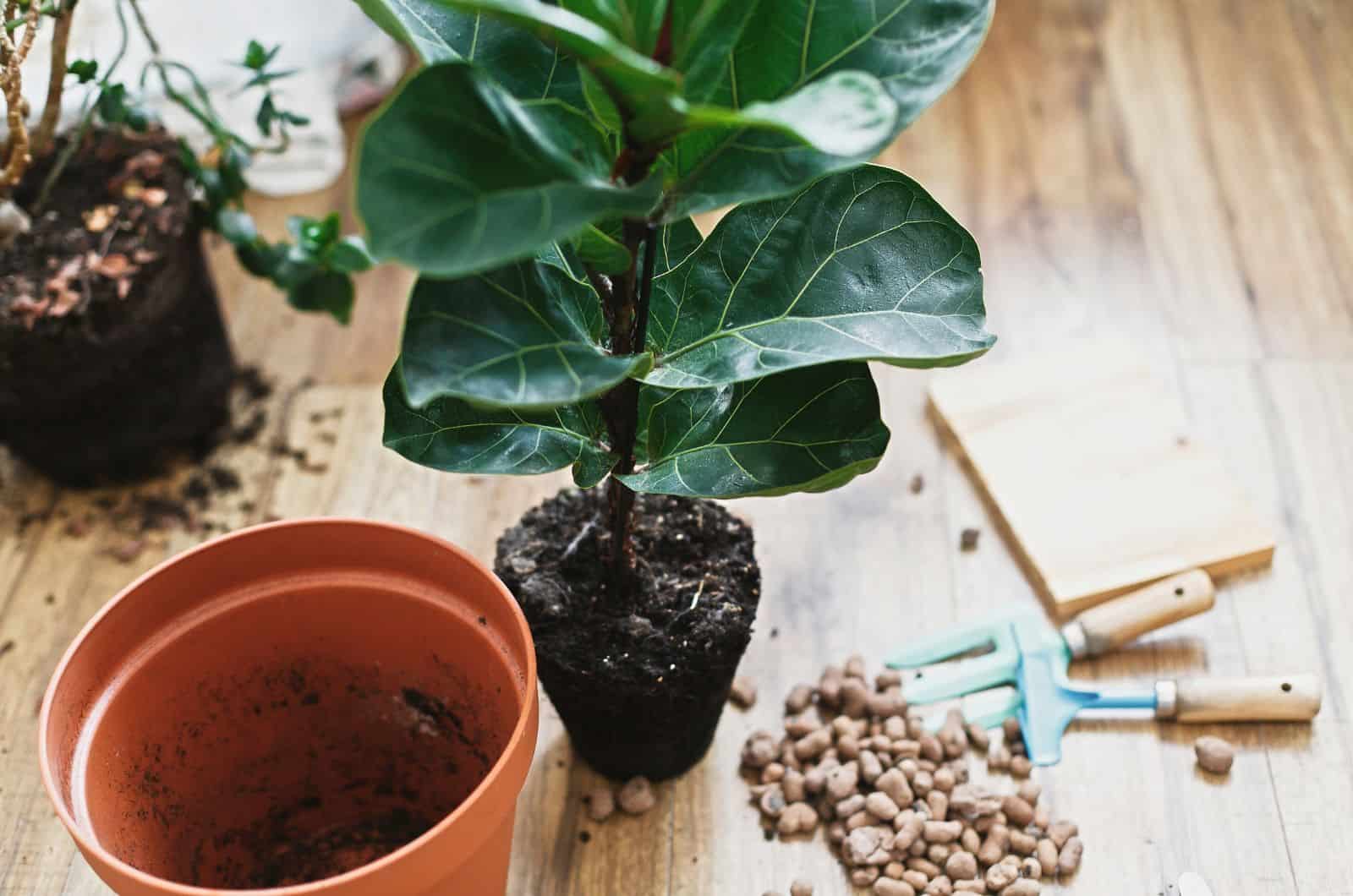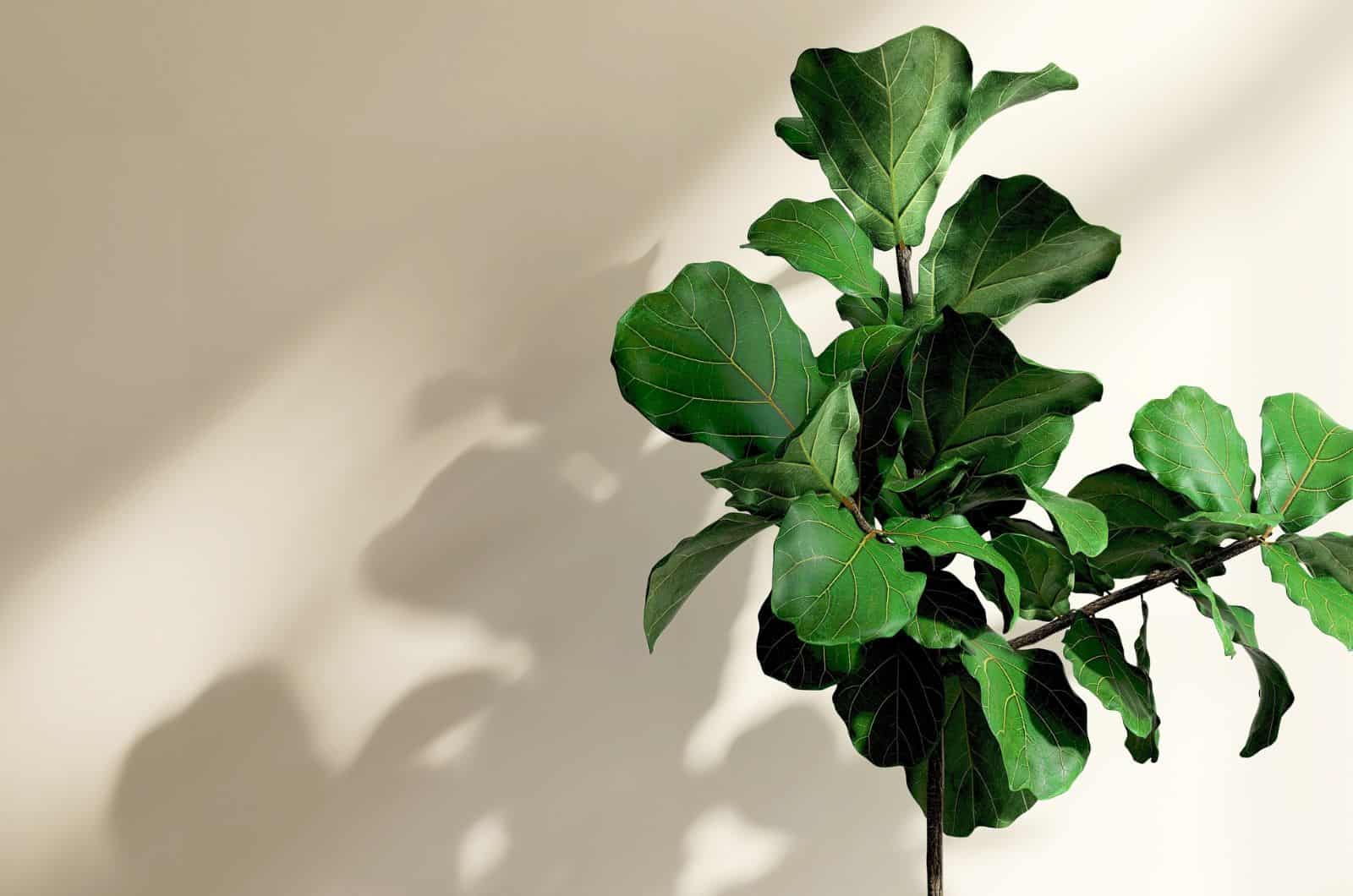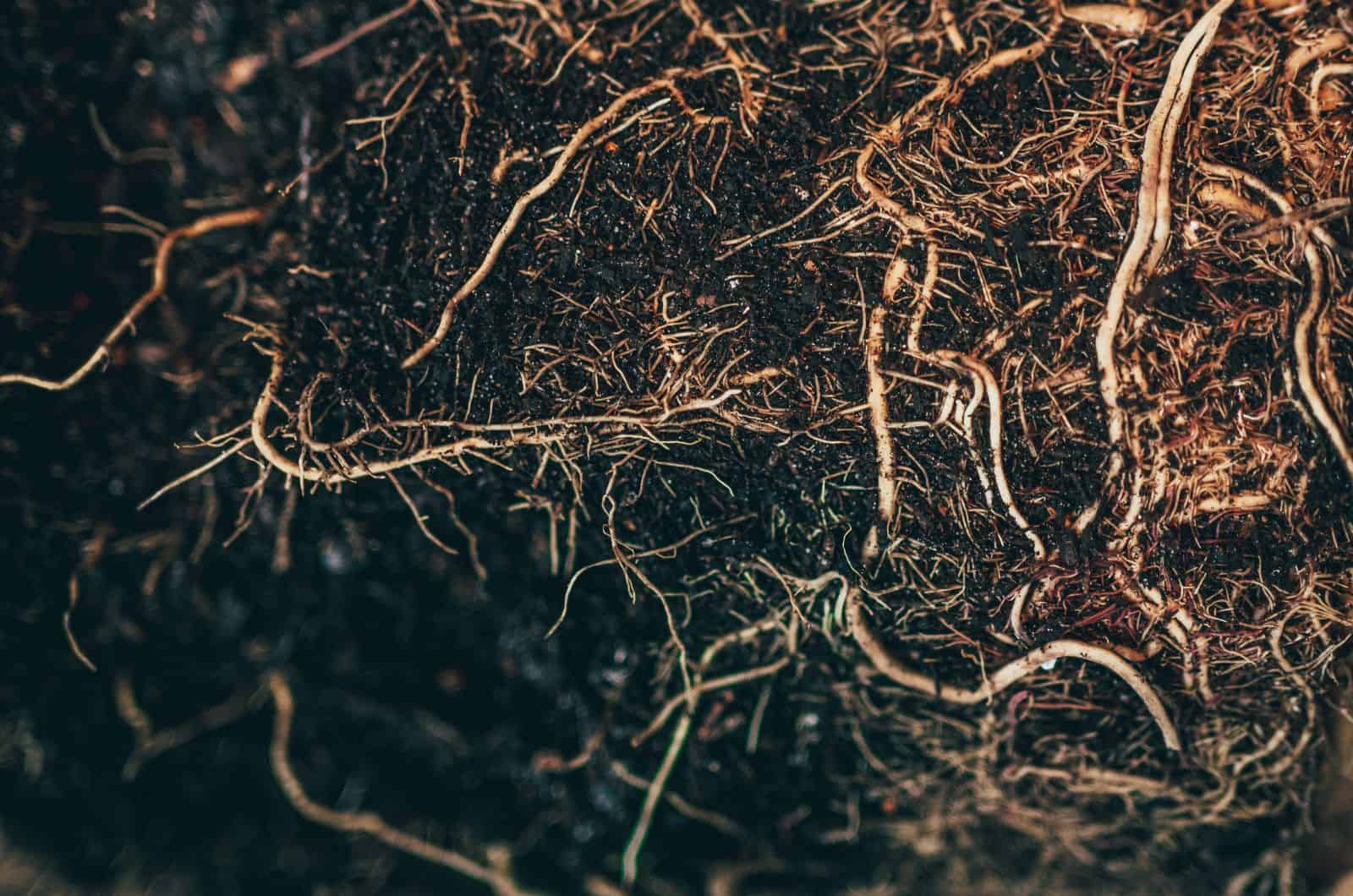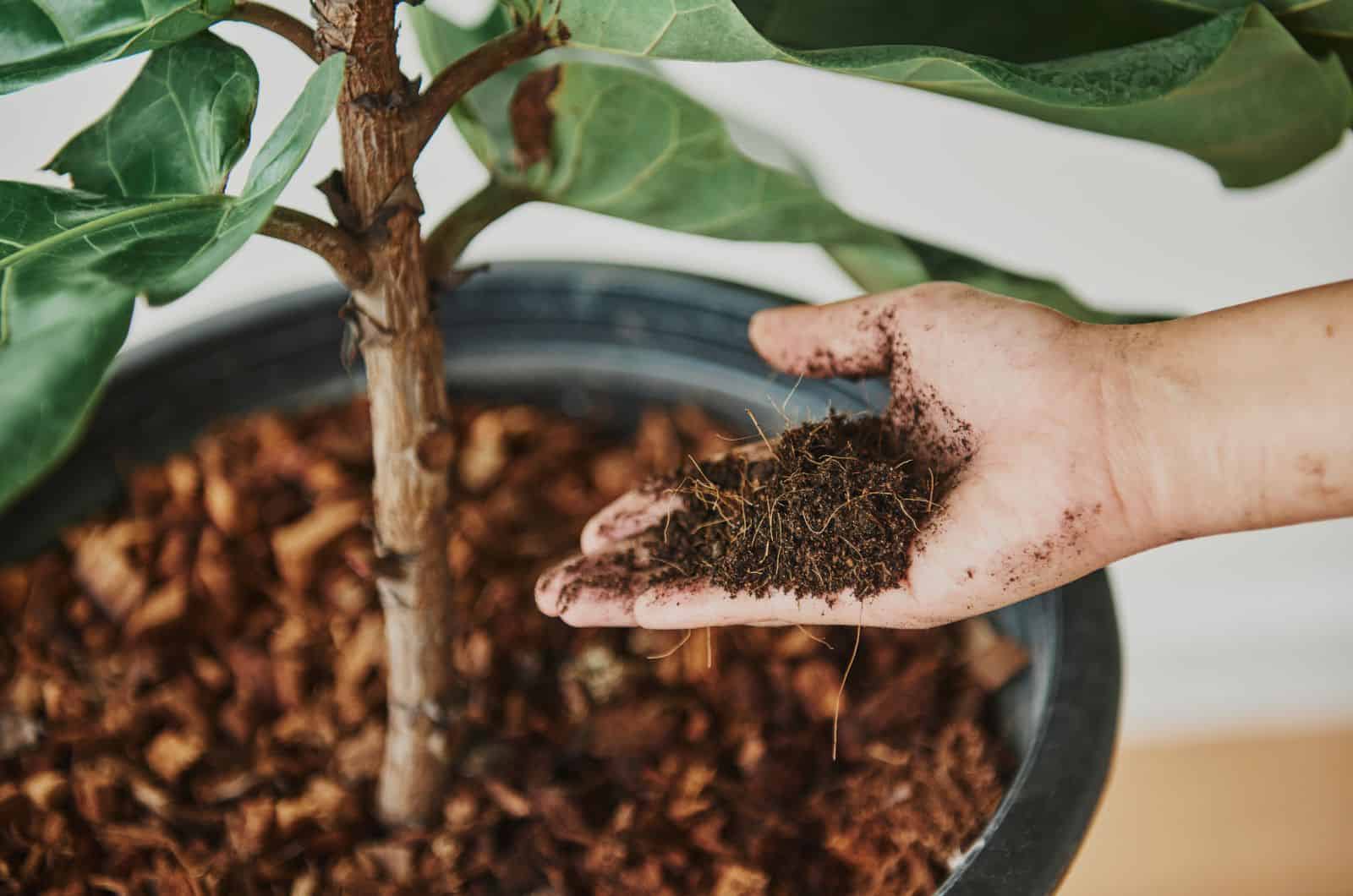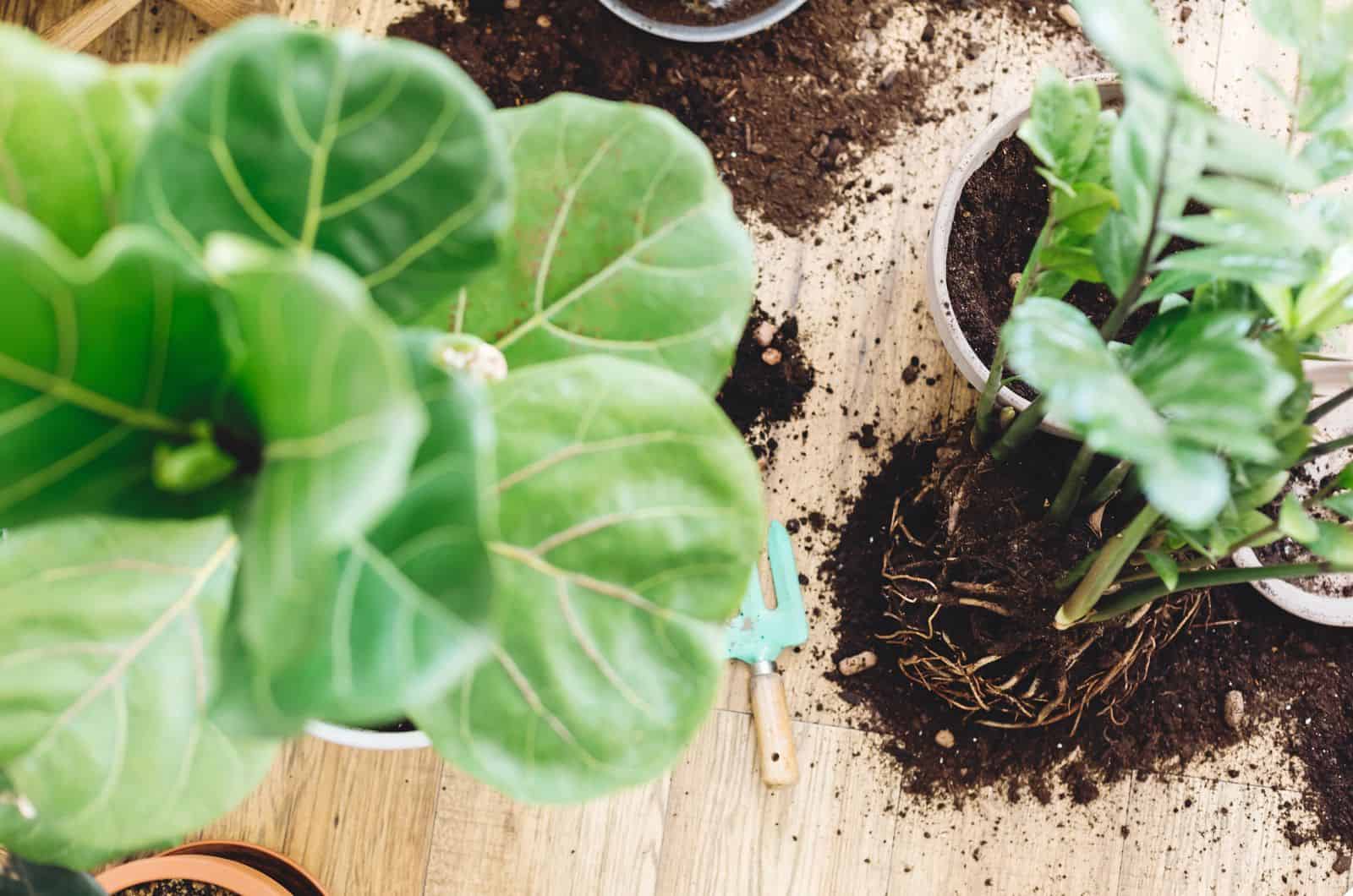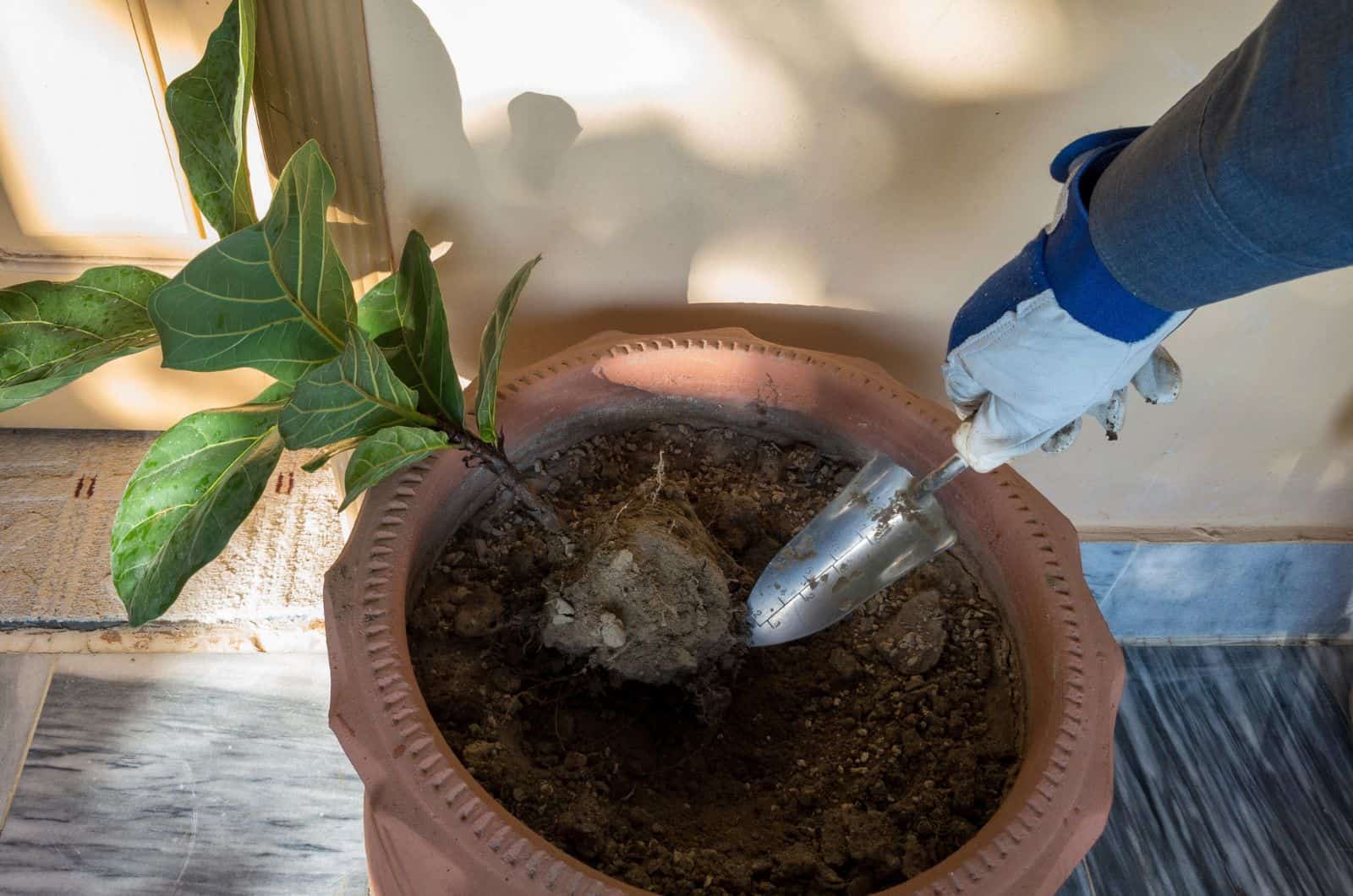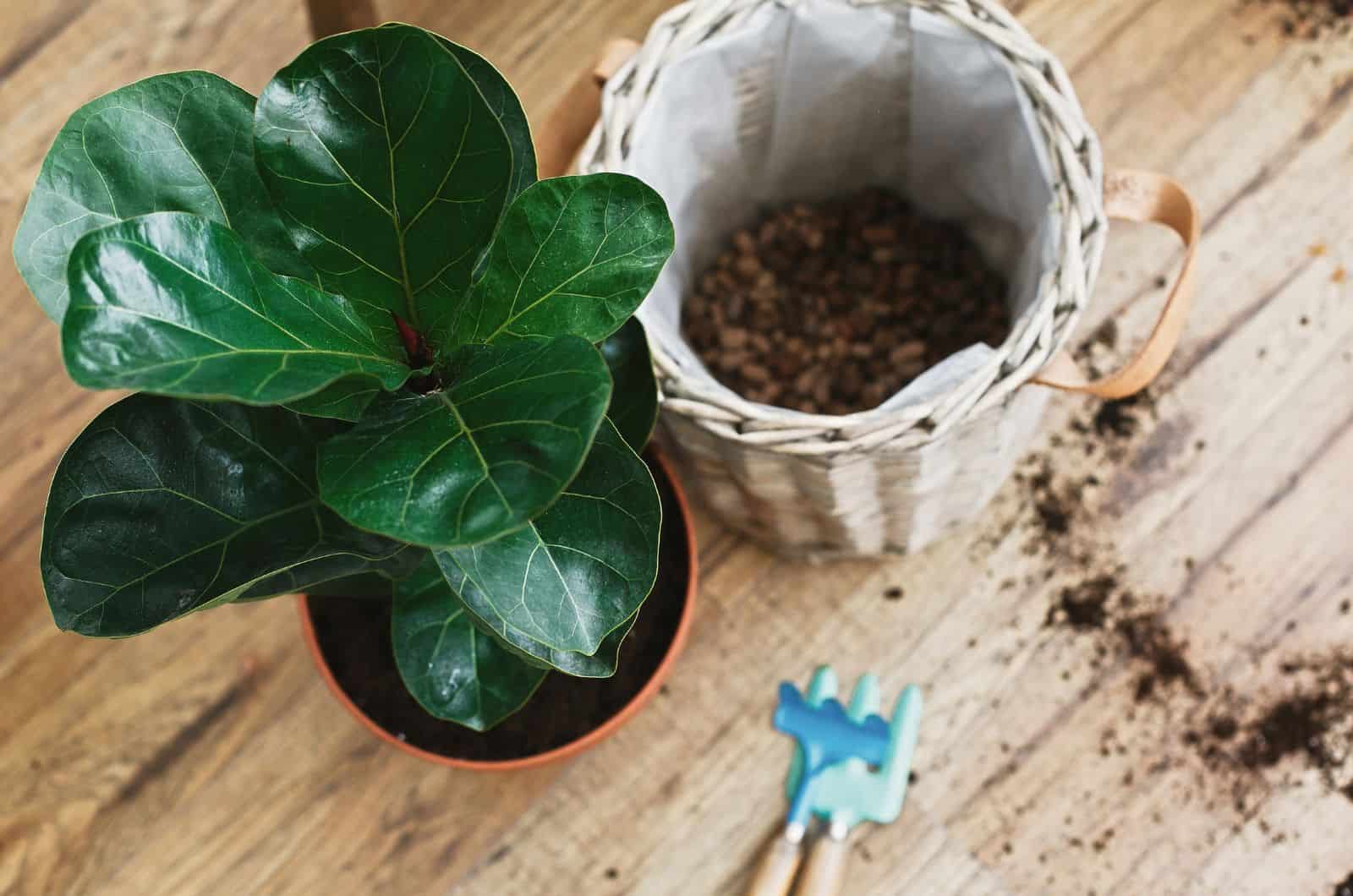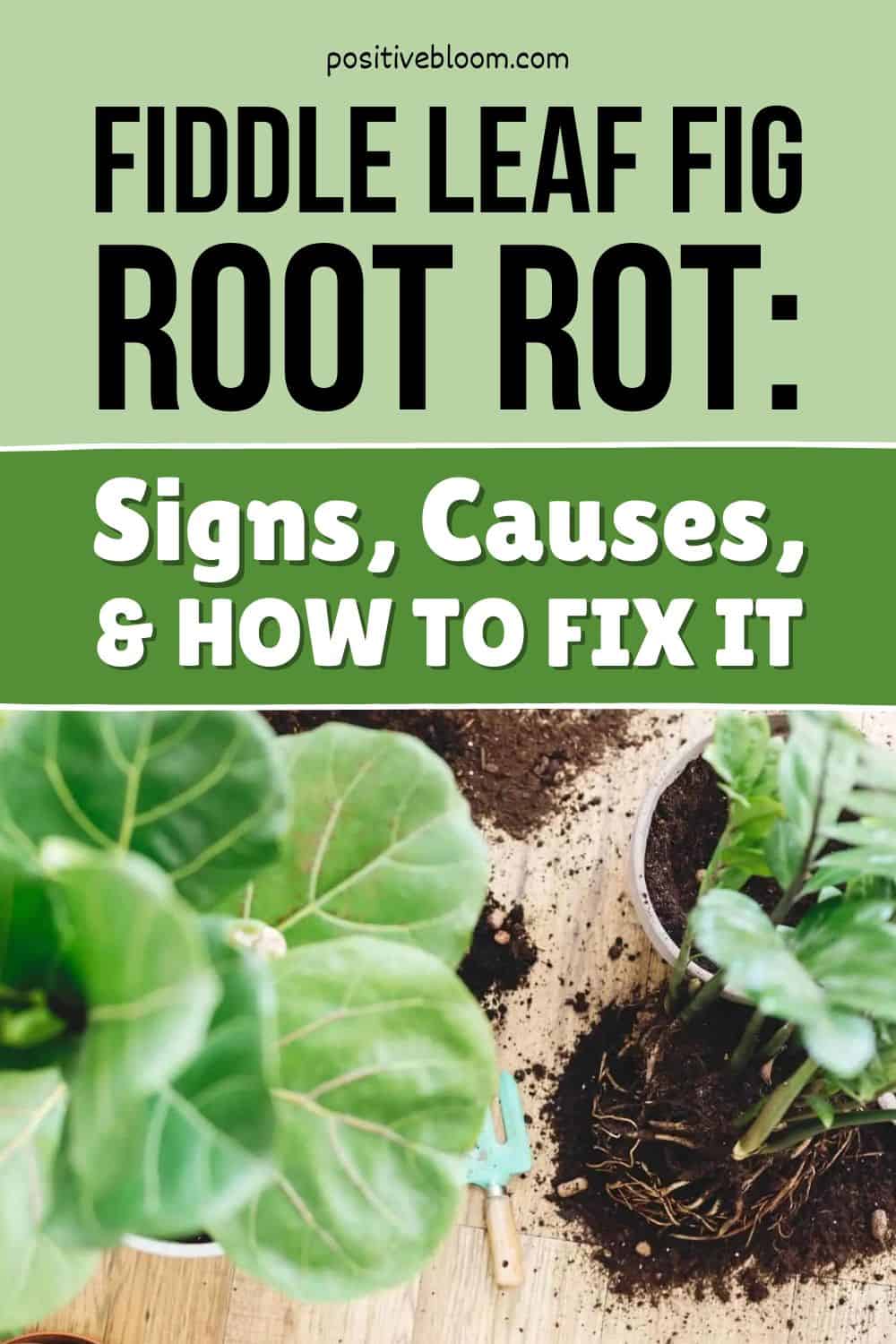When grown as houseplants, fiddle leaf fig plants can make a great addition to any part of your home. Their massive, dark green leaves with highlighted veins will take your breath away.
These plants are also known for their low-maintenance, which makes them perfect for beginner growers.
However, if you overdo it by providing your plant with too much water, you can create the opposite effect and cause fiddle leaf fig root rot!
This disease can be lethal for your plants, so you’ll need to treat it as soon as you spot any sign of root rot.
Therefore, you need to know both the signs and the causes of root rot. After determining these two factors, it’s time to treat root rot.
Let’s first learn how to recognize this disease in fiddle leaf fig plants!
Signs of Fiddle Leaf Fig Root Rot
Root rot can affect all indoor plants, and many plants display similar symptoms when they suffer from it.
If your fiddle leaf fig is suffering from root rot, it will display stunted growth, the leaves will start yellowing, wilting, browning, or developing brown spots, the soil will be mushy and smell unpleasant, the stem will start drooping, and the roots will be discolored.
It may be challenging to determine what’s wrong with your plant and to tell if it has rotten roots, as the signs mentioned above are also caused by other inappropriate conditions.
Let’s get into details!
Stunted Growth
Fiddle leaf figs have a fast growth rate, and grow up to 18 inches per year. However, this growth rate will occur only when all requirements are met.
If your fiddle fig doesn’t reach at least an inch per month, there might be some issues with the roots, such as rotting.
Be careful and don’t jump to conclusions if your plant doesn’t grow much during the winter because the Ficus lyrata is dormant during the winter months, which means it won’t grow much during that period.
Additionally, your banjo fig may also display stunted growth if the light levels aren’t optimum, if it suffers from nutrient deficiency, or if it’s dehydrated.
If you notice that your plant isn’t growing fast, you’ll need to inspect it further.
Let’s now take a look at what can happen with fiddle leaf fig leaves if they suffer from root rot.
Leaves Wilting
Although the best explanation for wilting is often underwatering, the leaves may also wilt if the roots are rotten.
However, this issue is closely related to the lack of water. In this case, the leaves still don’t receive enough water because the roots aren’t functioning. Remember that the primary function of fiddle leaf fig plant roots is to send water and nutrients to the other parts of the plant.
The fiddle leaf fig leaves may also curl if there’s something wrong with the roots.
When the roots stop functioning and you don’t spot the issue in time, the soil will begin to dry out and turn light brown, which indicates that the plant needs water.
The leaves don’t receive water anymore, so they start wilting.
Brown Spots And Brown Leaves
Brown spots don’t always appear when the roots are rotten, but if they do show up on your plant, you should check the roots.
First, you may notice red spots on the leaves that gradually turn brown. Eventually, the entire surface of the leaves will turn brown.
The edges of the spots may also start turning yellow, which indicates that your fiddle leaf fig is in the last stage of the disease and will likely die soon if you don’t take action.
Leaves Turning Yellow
Now we have another tricky situation. Yellow leaves often occur on plants, and it doesn’t necessarily mean that your plant is dying or something is wrong with the roots.
For example, your fiddle leaf fig may also be dehydrated, not receiving enough light, growing in high temperatures, facing pest infestation, or suffering from transplant shock.
But if you notice yellow leaves and rule out all the conditions above, you’ll need to check the root system as the roots may be dead and unable to send water and nutrients to the stem or FLF leaves.
Mushy Soil With A Foul Odor
A tell-tale sign of root rot is mushy soil. It’s important to learn the difference between wet and overly wet soil. For example, if the soil is dark brown, think back to the last time you watered it.
If it was long ago, you should put your finger into the soil, and if it’s mushy and sticks to the fingers with a pretty bad smell, root rot is the likely culprit.
The smell won’t be strong in the early stages of the disease, but as time passes it will get much stronger and be noticeable even from a distance.
As well as a strong rotting smell, the soil will develop mold in the last stages of the disease.
Your fiddle leaf fig is about to die in this case.
Discolored Roots
Diseased Ficus lyrata roots are brown or black, extremely damp and mushy, and occasionally even completely rotted away.
Healthy roots of a fiddle fig are grayish white or yellow in color. In comparison to slimy, rigid roots with root rot, they are also significantly firmer and more mobile.
The problem is that you can’t see the fiddle leaf fig roots until it’s out of the pot.
If you inspect the plant and notice the signs I mentioned above, the best option would be to remove the banjo fig from its pot and check the root system.
Drooping Stems
If your FLF has diseased roots that stop sending food and water to the leaves and the stem, the stem will start drooping.
If the stems start turning brown and mushy, your fiddle fig is close to death.
You need to start saving your plant! Keep reading to find out more.
Causes Of Fiddle Leaf Fig Root Rot
Before you can save your FLF, you need to know what caused the roots to start rotting.
The most common causes of root rot in fiddle leaf figs are overwatering, underwatering, overfertilization, and fungal or bacterial infection.
Let’s get into details!
Overwatering
The most common cause of rotten roots is overwatering. It’s essential to know why this occurs, as it’s not just about adding too much water once or twice.
In the case of overwatering, it stems from constantly supplying the roots with water they can’t absorb. As a result, they suffocate, stop functioning, and eventually rot, leaving you with an overwatered fiddle leaf fig.
The question is, what went wrong?! There are four possible answers; you were watering too frequently, the pot was too large and didn’t have drainage holes, or you used the wrong soil mix.
Let’s look into them further!
Watering Too Frequently
It takes a lot of time to figure out the perfect watering schedule for banjo fig plants. What works for one grower may not work for another.
This is because the amount of water and the watering frequency your FLF needs depends on various conditions like light, humidity, temperature, and soil type.
You shouldn’t water your banjo fig until you check the soil moisture. You’ll need to do this before each watering because the watering needs of your FLF change constantly.
By waterlogging the soil, we are inviting pathogens to spread everywhere until they eat the roots of our plants.
The Pot Is Too Large
Proper potting mix provides our FLF with nutrients, and even though it may seem like a good idea to use a larger pot that will fit more soil, it’s actually the worst thing you can do.
The roots will grow and spread, and will require a larger pot over time, but if too much soil is around the roots, there will also be too much water.
Not only will the roots stop growing, but they will also die, so choosing the pot according to size is the first step to a healthy plant.
The Pot Doesn’t Have Drainage Holes
Even if you choose the right sized pot, if it doesn’t have drainage holes you’ll face the same issues.
Your goal is to help the excess water find a way to come out of the soil.
When buying pots you shouldn’t pay much attention to the looks, but instead the size must be appropriate and they must have drainage holes in the bottom of the pot.
The Soil Mix Is Wrong
Another thing that will most certainly lead to overwatering is the wrong potting mix. Many people use regular potting soil because it’s readily available and affordable.
But houseplants, especially ones that initially grow in tropical regions, don’t like soil that’s too compact or with materials that retain water.
The same goes for the fiddle leaf fig. If the soil isn’t porous and retains water, your plant will most likely suffer from root rot.
We’ll discuss the perfect soil type for banjo figs later!
Underwatering
I discussed how the lack of water might cause yellow leaves on a FLF, but you need to know what’s actually going on below the soil surface.
Many growers, especially beginners, fear overwatering, and in order to avoid it they wait longer between waterings.
The roots have a defense mechanism of shrinking to store water, and as a result, some soil areas run out of roots.
When you start watering, the soil will retain moisture for too long and already weak roots will most likely rot.
Overfertilization
Constantly adding plant food to a fiddle leaf fig tree in the hope that it will grow better will actually have the opposite effect.
The roots will absorb all the nutrients in the beginning, and the plant will grow better and faster, but as time passes and the roots receive more food, they’ll stop working.
This is especially true for fertilizers that have higher concentrations of nitrogen.
The roots can’t absorb anything at this point, and if you keep supplying them with water, they’ll rot.
Fungal Infection
We need to know what to blame for this deadly root disease, and the names of the three main culprits are Pythium, Rhizoctonia, and Fusarium.
Who are these usual suspects? They are classified as fungi in science and are found in soil, but they can’t activate unless you are adding too much water to the soil.
However, these fungi won’t affect just one houseplant once they are activated, they can quickly spread to other indoor plants, such as Monsteras.
Bacterial Infection
One more cause of the most common root disease is the bacteria Erwinia chrysanthemi.
The name is pretty cute, but the bacteria is far from it; it destroys the roots and stems and causes them to rot.
You will help this bacteria spread if you keep adding water to the soil, don’t disinfect the tools you use for your plants, and if you are using old soil or an old pot when repotting other plants.
How To Fix Root Rot In A Fiddle Leaf Fig
If you have determined that your plant is suffering from root rot, you can contact the Fiddle Leaf Fig Plant Resource Center. Alternatively, the methods below have a high success rate, especially if you react as soon as you spot the first signs of disease.
You’ll need to repot your banjo fig, remove all the diseased leaves, and find a new place for the plant.
Let’s find out more!
Repot Your Banjo Fig
Luckily, you don’t need to be a pro gardener to repot a fiddle leaf fig. You’ll just need some tools used for houseplants, time, and patience.
Prepare gloves, a new pot, new soil, a pair of pruning shears, sanitizing solution, and hydrogen peroxide.
Let’s start repotting!
Take Your Ficus Lyrata Out Of The Pot
Your FLF first needs to be removed from the pot. Even though this may sound easy, it’s where everything can be messed up.
Follow this step-by-step guide on how to take the banjo fig out of its pot:
• Put on the gloves to avoid the infection spreading to the healthy roots.
• Lean the pot to the side and tap it gently to help the plant slide out. Please don’t pull it; even though the plant looks strong, if it is suffering from root disease it’s too weak to survive pulling.
• Now it’s time to expose the rootball. I always use a soft brush to remove the soil around the roots, as the healthy roots are also delicate.
• You can also wash the root system. Mature fiddle leaf figs are large, so I recommend using a garden hose.
Cut Off The Affected Roots
Now that your FLF is out of the pot, it’s time to get rid of the diseased roots.
• Sanitize your pruning shears with bleach or rubbing alcohol. Do this before each cut.
• Remove the damaged roots; I mentioned the difference between healthy and diseased roots, so please only remove discolored and mushy roots. Remember, you need to keep all the healthy roots!
• If you remove all the roots, you’ll need to dispose of your fiddle leaf fig. If you find some healthy fiddle leaf fig stem cuttings, you can use them for propagation in water.
Immerse Healthy Roots In Hydrogen Peroxide
• Mix a tbsp of hydrogen peroxide with one cup of water to disinfect the root system.
• Immerse the remaining roots in the mix or pour the mix into a spray bottle and spray it over the root system.
• Allow the FLF roots to dry entirely.
At this point, you can use root supplements to boost growth.
Place Your Plant In A New Pot
• Fill 1/3 of the new pot with fresh soil.
• Gently place your banjo fig in the pot and add the remaining soil.
• Give your Ficus lyrata a good soak.
Remove Damaged Leaves
If you follow all steps above, the underground structures of the plant are now healthy and in fresh soil.
• Inspect the leaves carefully.
• Sanitize your pruning shears and cut all the leaves that have changed color or have spots or lesions.
• If any of the new leaves are affected, remove them too.
Find A New Spot For The Plant
Now your plant is completely healthy, and you should make sure it stays that way!
Remember that your fiddle fig needs a lot of light in order to display new growth.
Choose a spot where your fig can receive bright indirect light.
Can A Fiddle Leaf Fig Recover From Root Rot?
The chances for recovery depend on several factors. First, you need to determine the severity of the infection.
If your plant hasn’t started dropping leaves, your fiddle fig has a great chance of recovery.
Of course, if you react as soon as you notice a few signs of root rot, your FLF will recover quickly.
It’ll take a lot of time for the FLF plant to recover if the leaves, stems, and majority of roots have been destroyed.
However, the plant is still alive as long as it has a couple of healthy roots.
If your plant can’t recover, but you found healthy stem cutting, you can propagate it to get a new plant. I know it’s not the same, but that’s the best you can do.
How To Prevent Root Rot?
If you pay attention to every aspect of plant care, you can prevent root rot completely.
You’ll need to change a couple of things, and it may take time to figure out the perfect conditions for your fiddle leaf fig, but once you get the gist of it, nothing bad will happen again.
Good Drainage
All potted plants fear poor drainage, even the ones that like moist soil! A well-draining soil is the best way to prevent root rotting.
How do we achieve this? First, you need the right sized pot made of the right material. It must also have drainage holes.
Terracotta or plastic pots are the most appropriate for fiddle leaf figs, although some may look unattractive.
You can always place such pots in decorative ones to achieve both appearance and efficiency.
Good Aeration
A suitable potting mix will aid drainage and also promote aeration, which is another essential factor for the roots.
In order for the roots to breathe, the soil must have enough air pockets for good water flow and air circulation.
For this type of plant, I highly recommend using a succulent or regular potting mix with perlite or pumice added.
Sand used for gardening is another great option.
What Is The Best Way To Water A Fiddle Leaf Fig?
The perfect watering schedule will make your life better – I mean plant life!
Here are some tips that will help you develop the perfect watering schedule and fulfill the watering needs of your fiddle leaf fig.
• A moisture meter is the best way to find out when to water your plants. You can find these devices on Amazon.
• Water when the topsoil is dry (one to two inches).
• When the temperatures are higher, your fiddle leaf fig needs more frequent watering.
• Use a watering can with a long goose-like neck and water thoroughly.
• Use rainwater or filtered water because the fiddle leaf fig is sensitive to the chlorine and fluoride found in tap water.
• Water in the early mornings to allow the water to evaporate gradually throughout the day.
• Be consistent and try not to forget your precious plant.
Check On Your Fiddle Leaf Fig Regularly
The best way to avoid problems with houseplants is by checking on them regularly.
Although root rot is most commonly caused by too much water in the soil, other factors also need to be considered.
Regular inspection will also help you avoid other issues such as pests.
Finally, if you create a perfect watering schedule and good environment for your fiddle leaf fig, it will be happy and healthy for many years to come!
Final Thoughts
Unfortunately, fiddle leaf fig root rot isn’t uncommon, but if spotted in time, the plant has a high chance for recovery.
If you notice yellow, brown, wilting, or curling leaves, mushy soil, or a foul odor, you can save your fiddle leaf fig by taking it out of the pot and removing the damaged roots.
Of course, it would be best to avoid these issues in the first place, so use our care tips to help your fiddle leaf fig thrive again!
Until next time!
Like this post? Share or pin it for later!

